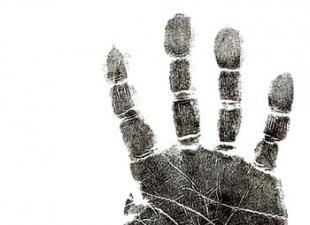Each of us is surrounded by a sea of information. And throughout life, we only do that we learn something and generate new ideas ... Sometimes it seems that the possibilities are already exhausted; the head is filled with not only "goodies", but also nonsense; and the next layer of important knowledge will simply not fit in it.
However, there are ways to connect the hidden resources of your brain. And one of the most effective is the mental map! With its help, famous scientists, businessmen, actors in a short time memorize a large amount of information and generate new ideas.
The complexity of the analysis of the corps of interviews often leads to a significant limitation of the number of respondents. In his work on the perception of the urban landscape of Boston, Los Angeles and Jersey City, Lynch is limited to a sample of 15 people at each site. With such a small number, analysts usually do not aspire to a complete view of the maternal population. They are often limited to a qualitative guarantee of a certain variety of the sample chosen, without creating a true sampling plan. The purpose of the interview is more heuristic than descriptive.
"Mentalka" is my first ...
Where else to take examples, if not from your own life! For the first time with the mental map, I myself, without knowing it, encountered in the distant childhood. Or rather, in the first grade. I could not memorize the poem that the teacher asked.For more than two hours, she repeated plain lines, but no sense to it ... It came to tears, and then papa intervened. He reread the poem several times, picked up a sheet of paper and pencils. And drew what was in the poem. Bird soaring in the blue sky; light steam trickle away; a girl in a long dress, walking on the grass, and the sun ... with red trees on it!
Questionnaires are tools for collecting qualitative and quantitative information from users of urban space, much more rigid in their structuring. The questionnaires consist mainly of a series of previously asked questions that the interviewee will formulate for the interviewees in order to collect answers. Other information about the interlocutor can be known and noted without having to ask specific questions. In particular, closed questionnaires differ from open questionnaires.
In a closed questionnaire, the text and the order of the questions are strictly foreseen in advance, and the respondent can choose his answer only from the list that is offered to him. in predicting answers related to the objectives of the study. However, in the open questionnaire, the wording and the order of the questions are fixed, but the person to whom the respondent can answer as he wishes, thereby enriching the range of answers received. Closed questionnaires are particularly well adapted to collecting quantitative information and demonstrating statistical relationships.
Since then, this picture is in my head, and I remember the poem of Vasily Zhukovsky, even if I wake up in the middle of the night. Here it is:
Lark
In the sun, a dark forest blushed,
In the valley, steam grows thin,
And the early song started singing
In the azure lark voiced.
He is loud with height
Sings, sparkling in the sun:
Spring came to us young
I'm singing the arrival of spring here!
Statistical analysis can go beyond these simple questions, and complex patterns of answers or causality can be demonstrated. Using a questionnaire with a target population is a consequence. Rarely a questionnaire can cover the entire population. For practical reasons of cost and time, or the impossibility of an exhaustive definition of the persons belonging to this population, we limit ourselves to a survey of a sample of this group of the population. To enable statistical conclusions for the entire maternal population from the survey results, the sample should be representative of the maternal population.
Now it is clear why in the picture of my dad the trees grew right on the Sun and were painted in bright red color? .. So it all became clear to me. Moreover, for the sake of maximum semantic transparency, Dad signed a “who is” girl in a long dress (Spring herself). What a bird flutters in the sky (the same lark). And he indicated that the bird is not just flying, but also singing (the very little cloud that you so often meet in comics, only with notes instead of words).
In more technical terms, this means that if a sample is stratified by several key variables that should influence the type of responses received, we will need to know the probability of each layer of the population appearing in the sample. In order to achieve such a result in accordance with the chosen stratification, a complete list of maternal population and a protocol of arbitrary drawing of persons to be interviewed will be required. If these procedures cannot be performed, quotas stratification will be used.
The interviewer will set quotas for different layers in the sample and avoid questioning additional persons in this layer after reaching the quota. As a rule, the interviewer must fill out a questionnaire next to the interlocutor. To reduce the cost and time of the survey, sometimes it can be done by phone, and more recently through the Internet, but in this case, the survey will affect only those who have a phone and the number is available. on the other hand, it is difficult to attract the interlocutor’s attention by telephone, which will be limited to this type of survey, especially for short questionnaires.
In general, without knowing it, the father managed to master a new method for himself and create a real (albeit absolutely primitive) “mentality”, which completed its task on “5+”! And, by the way, he used the most correct tools. What exactly - I will tell you further.
In all cases, strict programming of the behavior of the investigator is necessary so that all people are in the same situation, and therefore their answers are comparable and can be taken into account for statistical analysis. In order to present an example of a questionnaire for users of public space, we reproduce it in the following questionnaire, which is used with users of the Nice sites in relation to the analysis of functions, use and allocations and perceptions. This questionnaire is largely inspired by the “users” questionnaire developed by Mr. Bassand in a study of three sites in Geneva.
Branches to help you
Americans call the mental map the mind map, which means “intellectual map”. In my opinion, this name more fully describes this method of processing, structuring and storing information.The mind map method can be useful in a variety of situations. Lecture notes; a summary of a book or movie; creating a “live” presentation for business negotiations; fixing another idea that just awaits its realization ... There are many situations where the virtually limitless possibilities of the mind map can come to the rescue.
It should be emphasized that no sample stratification method was used by students who interrogated users. The results obtained in our analysis will not be used for reliable conclusions for all users of the site and have a rather anecdotal value, referring to the answers received by users who meet on a particular day in the time interval data at these sites.
Thus, one questionnaire allowed users to ask questions about their use and their perception of the place. The final category of the question gives an idea of the social and professional user profile. If b: could you tell me which ones?
But what does the average "mind map" look like? Usually it is based on one single topic. It must be placed in the center of the sheet, highlighted in bright color, marked in large letters, enclosed in a closed loop - in a word, so that the subject catches the eye to the maximum. It will become a kind of core, from which “tentacles” crawl in different directions - either subtopics or keywords.
When to use mental maps?
See an exhibition, an exhibition, take part in a party. Have a drink or lunch. Meet people. Discuss, see knowledge. Time to fill out the form. One or more times a day. Between once a week and once a month. For practical reasons, if so, which ones?
I like this place. Are there elements that should not disappear? As for the iconographic documents, which allow analyzing the perception of the urban space, the analyst could resort to the corpus of representations of this space on the part of artists. The latter, however, are unusual observers in the literal sense of the word, using the urban space in a project of artistic creation that feeds on a cultural past and very special views. To analyze the perception of ordinary users of urban space, geographers and city planners use the tool of mental maps.

Further more. From the larger "branches" are thinner "processes." Each word or thought that underlies them should be as capacious and memorable as possible. As a result, we get a bright pattern, similar to an expanded tree with many small branches.

A few details to pay attention to.
Then the geographer-town planner proposes various protocols for formalized analysis of sets of mental maps. A mental map can be defined as an organized representation that a person makes part of his spatial environment. In order to receive a mental map, respondents are asked to allocate a place on a sheet of white paper, without the interlocutor having the opportunity to view the urban landscape that is proposed to be presented. The purpose of drawing is to reproduce the mental, filtered, conceptualized and memorized image of places, without exposing oneself to attempts to approach a visually perceived reality.
Mind map helps to sort out virtually any topic; the main thing is the experience of making and reading smart cards. And this is a new thing.
Everyone has his own card
Examples snatched from life, most clearly demonstrate the effectiveness of mental maps. So, my cousin Katya decided to master this method in order to learn a foreign language and marry a German resident.Due to the fact that the German language was absolutely alien to her, she began with the simplest thing: vocabulary replenishment. For this, it designated a topic in the center of each mental picture (for example, “foodstuffs” - “LEBENSMITTEL”), and from this core “extended” to the direction of the arrow. These were “fruits” (“früchte”), “vegetables, greens” (“gemüse”), meat (“fleisch), etc.
Of course, the interviewees choose certain elements and forget about others. Some aspects are underlined, even exaggerated, others are minimized. Comparing the maps with each other and with the topographic map, linking the distortions and preferences of individual elements with the socio-demographic profiles, cultural affiliation and practice of the places of the respondents, we can unravel, understand and explain the vision that people have this place and the methods that flow from him
The idea of a mental map was first introduced by psychologists in an attempt to study the modalities of spatial perception of people. It was consistently developed by geographers as a tool for analyzing spaces as perceived spaces. Bely learns through mental maps the perception of countries, regions and geopolitical groups from residents with different socio-ethnic affiliation. They also propose the first methods of treatment in order to generalize the representations of mental maps and subject them to quantitative treatment.
Naturally, it not only indicated the names of certain products or objects, but also painted them.
Katya hung up these mental maps in different rooms of her house; in the office; where she worked; drove in the glove compartment of the car. As a result, the constant “vision” of unfamiliar words and their images helped her to expand her vocabulary as soon as possible. This method has helped her in the further, more complex stages of learning German.
Lynch was one of the first authors to use mental maps to represent urban spaces. More precisely, Lynch identifies two types of cards from mental maps of residents of Boston, Los Angeles and Jersey City. The first is a route mapping, a mental map that reproduces a series of chained links between selected points and their associated indices. The second is the mapping of flights, the organization of a number of places in accordance with a more complex network of connections and associative relations, which is an ergonomic issue in the field of space education, aimed at filling gaps that are not studied directly in everyday practice.
In fact, the construction of mental maps does not require any special skills. The main thing is to follow your own intuition and not to copy those mind maps that you saw before. After all, a map that will be understandable to one person will not help another at all. This method is extremely individual, and if your goal is to create mental maps, you should not call a friend for help.
Rowntree's view of the urban spaces of Strasbourg and Anger, respectively, make extensive use of the mental map tool. Covin analyzes the deformations caused by mental maps in the Euclidean space of a topographic map in order to relate them to the practice of urban space. The mental maps are organized according to the components that facilitate the representation of space: the structuring axes, the relations between these axes, perceived limits, symbolic properties and functions.
Space is considered as a territory in which people with different perceptions act in accordance with their social and spatial practice, supplemented by an idealistic load that lies within their values. Then the mental map is able to reveal the hidden dimensions of the feeling of a place, easier than long interviews. A graphical representation is what replaces the physical environment, the layer is both a model and a simplification. Mental maps are cognitive objects, evidence of relationships that subjects maintain within and with the territory.
"Intellectual" and its features
There are several nuances that allow you to create the most effective "mentality".
Here they are:
- a sheet of paper should be in a horizontal state. So we get the maximum space that can be filled with bright images and keywords.
- do not forget about the pictures. They are the main component of each “mind map”, as they slam into memory much more efficiently than letters or numbers.
- constructing mental maps implies the use of paints. Create colorful pictures, sign them with pencils of different shades. The brighter your work will be, the faster and clearer it will fall into the memory space.
- when signing these or other plots, use different fonts. This method only welcomes any manifestations of their own "I." It is no coincidence that experts call the compilation of intelligent maps "a graphic representation of the work of the brain."
Knowing how to make a mental map, we save time, nerves and money. So take the paper, colored pencils - and go ahead, the mind map method is waiting for you!
With more careful reading, we call the mental map both the mental model of the organization of space on the part of the individual, and the pattern that objectifies this mental model. As a mental model, the mental map provides several functions: the adaptive function of solving spatial problems, the symbolic function of interpersonal communication, and the expressive function of personal identity. As a picture, the interpretation of the mental map should take into account the different ability of the subjects to interrogate the use of a graphic representation.
Good time, dear readers and guests of the blog!
Today I want to talk with you about one interesting technique that will help you analyze any information better and more efficiently: the mental map - you will learn examples of some of them from this article.
This method is not so complicated, and its applicability knows no bounds. After all, all of us sometimes find ourselves in a situation where we need to urgently sort out some business, material, or maybe even our own life? In this case, you should definitely get acquainted with mind mapping!
Mental map: how to make
Using mental maps as tools for analyzing the perception of urban spaces nevertheless creates several problems. First, it is extremely difficult to control, in the statistical sense of the term, the experience that the subjects have in memory reproduced on the mental map, and this in order to link this experience with the characteristics of the map. mental model of the map and reproduced as intended.
Then, as soon as mental maps are approved as objectively objectified mental representations, the problem of their analysis arises. The blackening of a number of mental maps should in fact create the general characteristics of all, characteristic of some characters, and others, ultimately, peculiar to everyone. These points were considered differently by the authors who worked with mind maps. Decisions are beginning to appear, but it is still far from a consensus methodology for analyzing and using the knowledge provided by mental maps.
A small outline of the article:
- What is a mental map?
- How are the mind maps created?
- What to look for when mindmapping
- Types of programs for creating mental maps
- The use of mental maps in life.
What kind of beast is this?
Mental maps (mind mapping, maindmapping) is a convenient way to structure information, where the main topic is in the center of the sheet, and related concepts are placed around in the form of tree diagram.
Here psychology, mnemonics and neurolinguistics are successfully combined. In this article you will see examples of such cards.
One of my maps, plan for the month:

For the first time this technique was proposed by Tony Buzan, a British psychologist. He explains the high efficiency of mental maps by the peculiarity of human psychology to perceive information entirely and nonlinearly, as if by scanning.
Therefore, the familiar kilometers of text in ordinary outlines are so quickly tiring and boring, you know.
How it's done?
As stated above, the mental map is such a voluminous tree-like system. At the very beginning of use, you need to decide on topic - a word or a small definition that will set the direction for all the resulting data.
“Flowing” is not simply said: you need to set different trends of the subsequent information, drawing new and new branches.
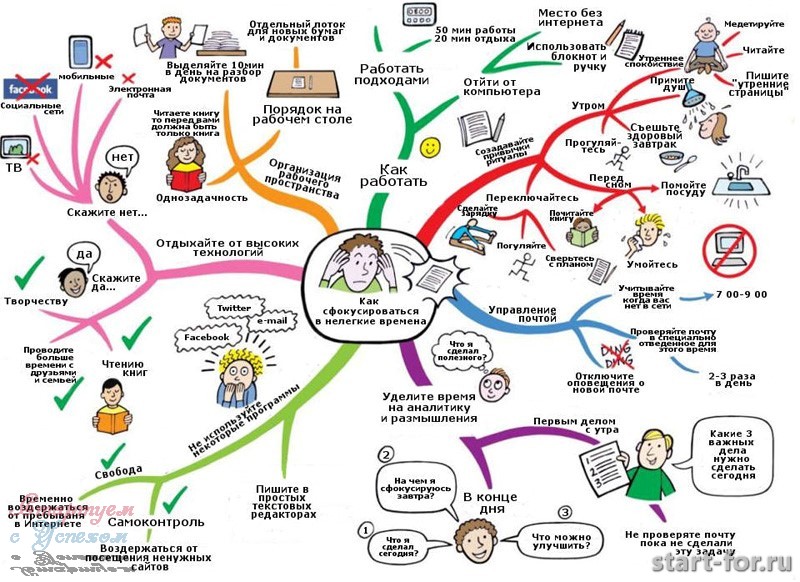
A huge plus of using mental maps is that here, in fact, there can be no unnecessary information! All the details that would have been omitted in a regular table or a summary will find their place on the smaller branches of our system, and the details of these details on even smaller branches!
In this regard, the use of mental maps is very convenient when you need to understand your own thoughts and desires.
You can record anything, all associations and pop-up thoughts, without any problems structuring information into the main and flowing: the whole picture will be formed by itself.
A few details to pay attention to:
1. Bright colors
Human psychology is structured in such a way that at first we perceive the colors, lines, general structure, and then we enter into the symbols, which are the letters that make up the text. Therefore, it is useful to highlight outstanding moments with bright pens, markers, pencils and other things.
2. Special styles
Based on the same principle of psychology, it would be nice if, when using a map, each branch is framed in a special, different style from other branches. In this case, there will be less chance of confusing the information, since the data will not be associated with each other on subconscious level
3. Designation system
The chain of thoughts in the mind can arise very quickly, and another one can also be quickly replaced. Therefore, in order to eliminate the risk of incomplete filling in a mental map, I recommend you to think up and put your own system of symbols into use: to save time.
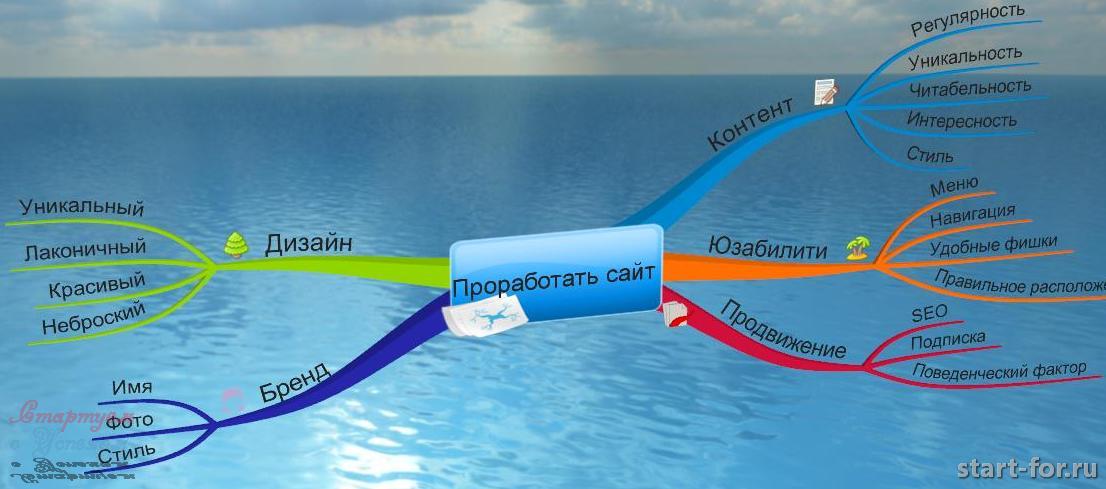
4. Illustrations and images
Do not be limited to text alone. Additional visual materials will make the information enclosed in the card even easier to read.
5. Additional notes
The whole effect can be lost if you start to overdo it with text. To deepen the material, you can use footnotes on special small paper-bookmarks, where the mentioned topic will be explained in a little more detail than the map allows.
6. Unambiguity
Clearly state the material at the map levels, otherwise the mental map will not fulfill its main task: it will not help you to analyze information more successfully.
Computer programs
You don’t have to compile the whole map by hand, because there are special programs that help to perform mind mapping in digital mode.
Here are some of them:
iMindMap - this is the program I used before, very easy to use, it turns out beautiful and effective cards. I am well acquainted with her, in the following I will tell in more detail.
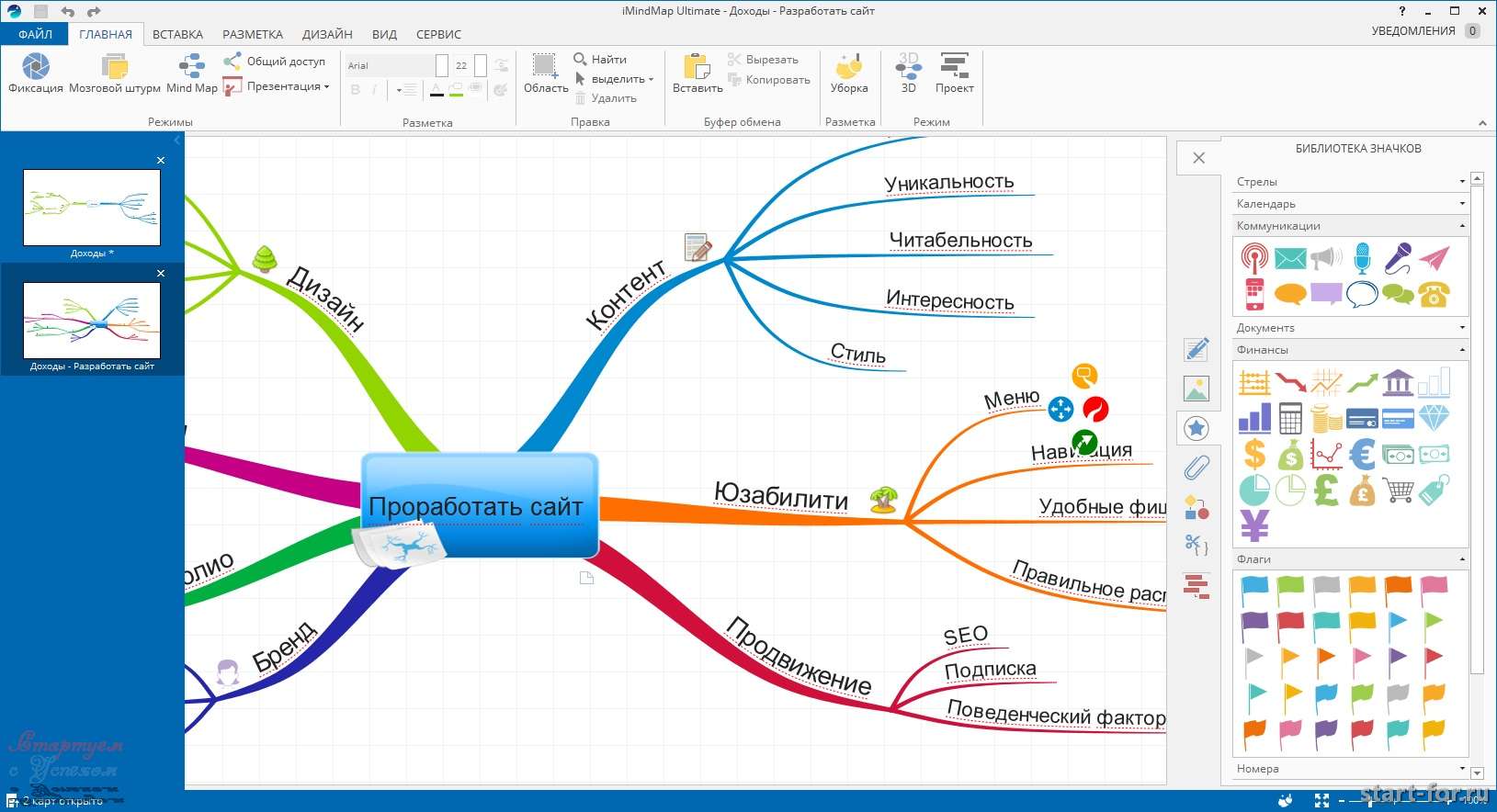
But it has a significant disadvantage - a great value, it is worth buying if you are going to use it all the time, I switched to paper ones, and in the examples my old cards ...
Coggle - simple interface and plenty of features. Allows you to create high-quality mental maps in a short time. You can upload files by simply dragging and dropping from your desktop.
Allows collaboration on a single card. There is a cancel function, as well as a detailed history of changes.
Xmind is a popular cross-platform program that exists in both free and paid versions. Besides mind mapping, it supports ishikawa charts. Good enough for time management.
Mapul is a paid program that runs on a monthly subscription. Excellent for its original design. Good for creating handwritten maps, there is Russian in the settings.
MindMeister is a simple program without a confusing interface. There is an application for Android and iOS. Generally paid, but there is a free trial. Allows you to work together in real time.
WiseMapping is a program that allows you to work on maps online without downloading to your computer. Supports both collaborative and personal work. Allows you to export the finished product to another format, paste into sites, presentations and more.
Application of intelligence cards
Mental maps can be useful in various areas of our life:
1. Study new material
As in schools, universities and at various courses, and with self-education. It makes sense to abandon the usual linear notes and go to the mental maps.
With intelligence cards, it becomes easier to perceive new information. This is due to accented cause-and-effect relationships, so the process of mastering the material is faster.
In addition, it can save time, because when writing long notes it takes you time to write, and then reread not very important material.
And since in sections of information you design all topics and subtopics as a multi-level system, you will not have time for a long search and decryption of the material.
Therefore, mindmapping is a worthy alternative.
2. Analysis of life situations
When it is difficult to figure out what to do, what choice to make and what actions to take, mind mapping also comes to the rescue.
Consistently laying out information on the shelves-branches, you can unexpectedly see for yourself the situation with new sides, to deal with the details and to detect imperceptible at first glance exits and capabilities.
3. Self-knowledge
It is difficult to determine the profession, the profile of study, and generally live in the modern world, if you yourself do not know what you can and what you want.
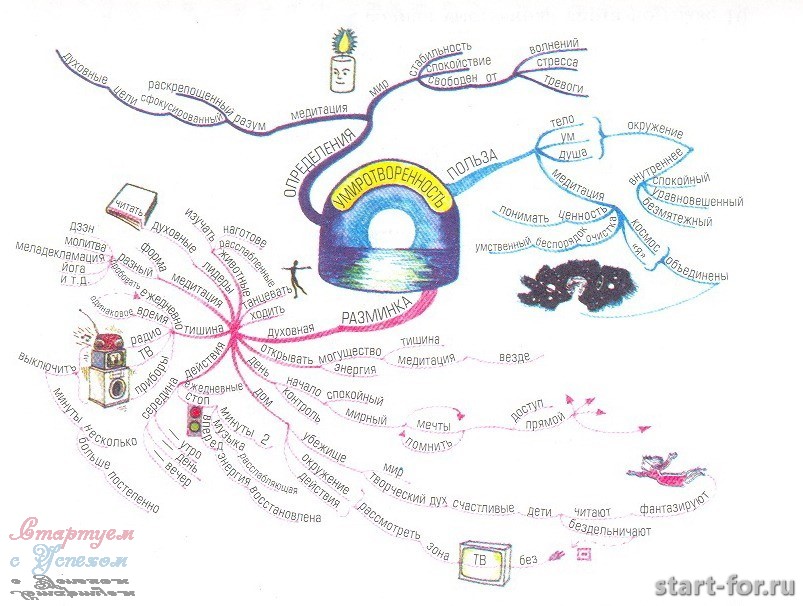
Cards of mind allow you to accurately analyze your emotions, feelings and tastes, helping to identify sometimes unexpected reasons for this state of affairs.
4. Self-development
With the help of mental maps, it is quite convenient to control your own progress and progress towards your goals. It also helps to organize your time and distribution of efforts, not allowing you to hide from the attention of small things, ignoring of which often leads to losses.
5. Planning
I quite often make a plan in the form of a map, for example, almost every article on a blog begins with drawing up a plan for an article, in more detail it is possible.
Well, you can look at the drawn up plan for the month with the example above, the plan for December is just there, though in 2014 ...
But we are striving for success, right? Never give up, and let the intellect card be your faithful helpers even in the most complicated situations!
On this I think it's time to finish, all the best!
 magicov.ru Secrets of magic.
magicov.ru Secrets of magic.


